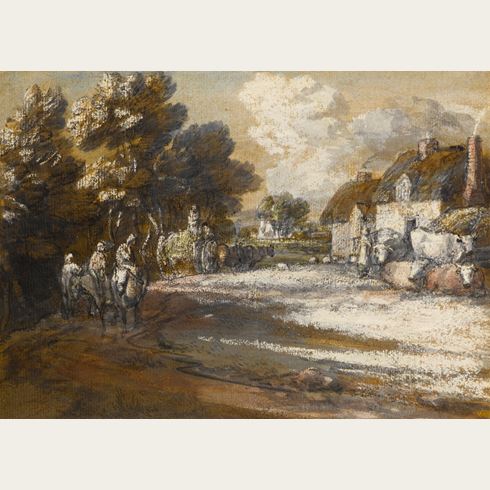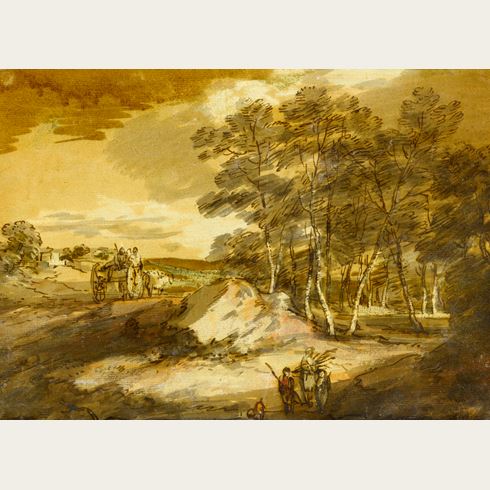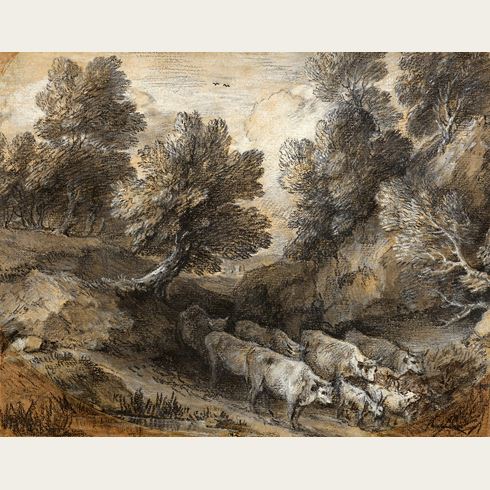Thomas GAINSBOROUGH
(Sudbury 1727 - London 1788)
Study of a Clump of Trees
Sold
Pencil and red chalk.
190 x 149 mm. (7 1/2 x 5 7/8 in.)
Watermark: Partial.
190 x 149 mm. (7 1/2 x 5 7/8 in.)
Watermark: Partial.
Thomas Gainsborough’s landscape drawings evince a deeply personal, and often quite poetic, view of nature. As a friend and early biographer, Philip Thicknesse, noted of the artist, ‘Mr. Gainsborough, like the best Poets, was born a Painter, for he told me, that during his Boy-hood, though he had no idea of becoming a Painter then, yet there was not a Picturesque clump of Trees, nor even a single Tree of beauty, no, nor hedge row, stone, or post, at the corner of the Lanes, for some miles round about the place of his nativity, that he had not so perfectly in his mind’s eye, that had he known he could use a pencil, he could have perfectly delineated.’
Thicknesse goes on to claim that one of Gainsborough’s very first drawings, which the artist presented to him, was a pencil sketch of a group of trees, ‘accompanied with a great many sketches of Trees, Rocks, Shepherds, Plough-men, and pastoral scenes, drawn on slips of paper, or old dirty letters, which he called his riding School, and which have all been given, borrowed, or taken awayfrom me, except his first wonderful Sketch.’ Similarly, as the artist’s friend and longstanding champion, the journalist Sir Henry Bate Dudley, wrote in an obituary of Gainsborough, ‘Nature was his teacher and the woods of Suffolk his academy; here he would pass in solitude his moments in making a sketch of an antiquated tree, a marshy brook, a few cattle, a sheep herd and his flock, or any other accidental objects that were present.’
This rapidly drawn study of trees, previously unknown to scholars, may be dated to the early part of Gainsborough’s career, when he was living in his native Suffolk. It is probably from a small sketchbook, as its size is identical to several other early plein-air studies. The attribution of the present sheet has been confirmed by the Gainsborough scholar Hugh Belsey, who points out that it is a unique example among the artist’s early drawings in its use of a striking combination of pencil and red chalk.
A number of comparable nature studies of the same period and of similar dimensions are also likely to have been part of one or more sketchbooks. Belsey likens the present sheet in particular with a double-sided pencil drawing of a Country Track with Trees, of identical dimensions, in a private English collection, which he has dated to the late 1740s. Among other stylistically similar early drawings is a study of trees in a wood, formerly in the Oppé collection and now in Tate Britain, which may have come from the same or a similar sketchbook. At an auction in London in 1799, Gainsborough’s daughter Margaret offered for sale ten sketchbooks used by her father, and the present sheet is likely to have come from one of these.
Thicknesse goes on to claim that one of Gainsborough’s very first drawings, which the artist presented to him, was a pencil sketch of a group of trees, ‘accompanied with a great many sketches of Trees, Rocks, Shepherds, Plough-men, and pastoral scenes, drawn on slips of paper, or old dirty letters, which he called his riding School, and which have all been given, borrowed, or taken awayfrom me, except his first wonderful Sketch.’ Similarly, as the artist’s friend and longstanding champion, the journalist Sir Henry Bate Dudley, wrote in an obituary of Gainsborough, ‘Nature was his teacher and the woods of Suffolk his academy; here he would pass in solitude his moments in making a sketch of an antiquated tree, a marshy brook, a few cattle, a sheep herd and his flock, or any other accidental objects that were present.’
This rapidly drawn study of trees, previously unknown to scholars, may be dated to the early part of Gainsborough’s career, when he was living in his native Suffolk. It is probably from a small sketchbook, as its size is identical to several other early plein-air studies. The attribution of the present sheet has been confirmed by the Gainsborough scholar Hugh Belsey, who points out that it is a unique example among the artist’s early drawings in its use of a striking combination of pencil and red chalk.
A number of comparable nature studies of the same period and of similar dimensions are also likely to have been part of one or more sketchbooks. Belsey likens the present sheet in particular with a double-sided pencil drawing of a Country Track with Trees, of identical dimensions, in a private English collection, which he has dated to the late 1740s. Among other stylistically similar early drawings is a study of trees in a wood, formerly in the Oppé collection and now in Tate Britain, which may have come from the same or a similar sketchbook. At an auction in London in 1799, Gainsborough’s daughter Margaret offered for sale ten sketchbooks used by her father, and the present sheet is likely to have come from one of these.
The musician William Jackson, a close friend of the artist and an early biographer, wrote that ‘If I were to rest his reputation upon one point; it should be on his Drawings...No man ever possessed methods so various in producing effect, and all excellent.’ A prolific draughtsman, Gainsborough apparently never sold any of his drawings, although he is thought to have given away many of them as presents. As Susan Sloman has noted, ‘During his lifetime Gainsborough’s drawings were known to an inner circle of friends, artist and connoisseurs, but not to the wider public.’
Provenance
Probably the estate of the artist, and by descent to his daughter Margaret
Probably her sale, London, Christie’s, 11 May 1799, part of lots 81-90
Private collection.
Probably her sale, London, Christie’s, 11 May 1799, part of lots 81-90
Private collection.








